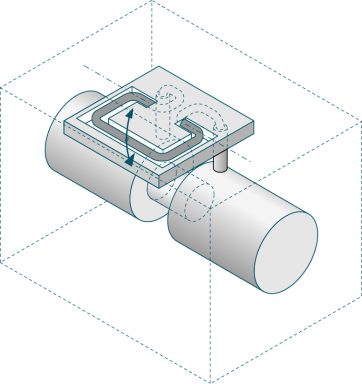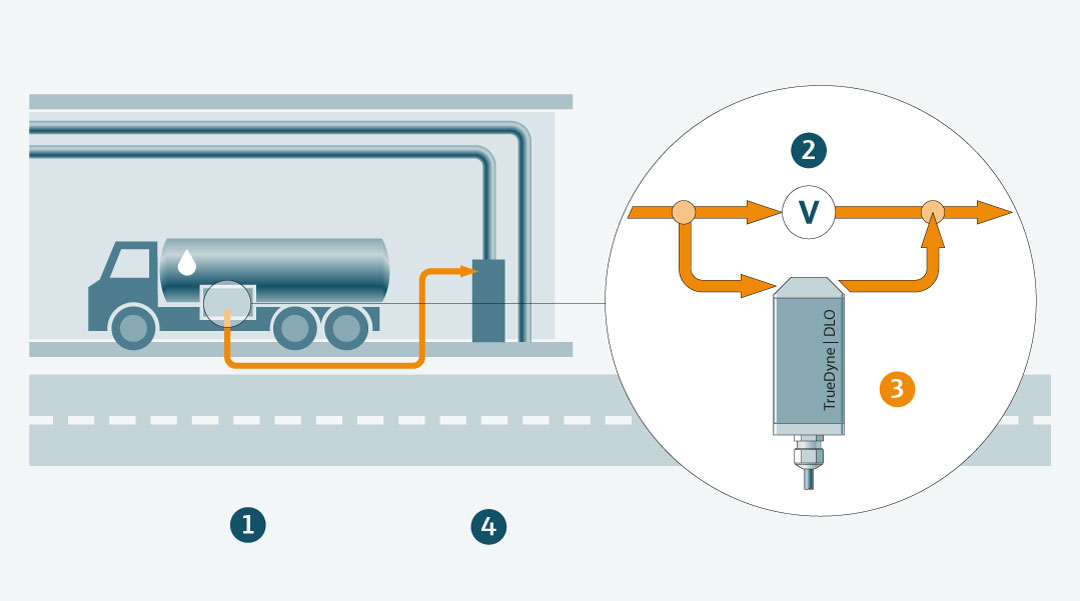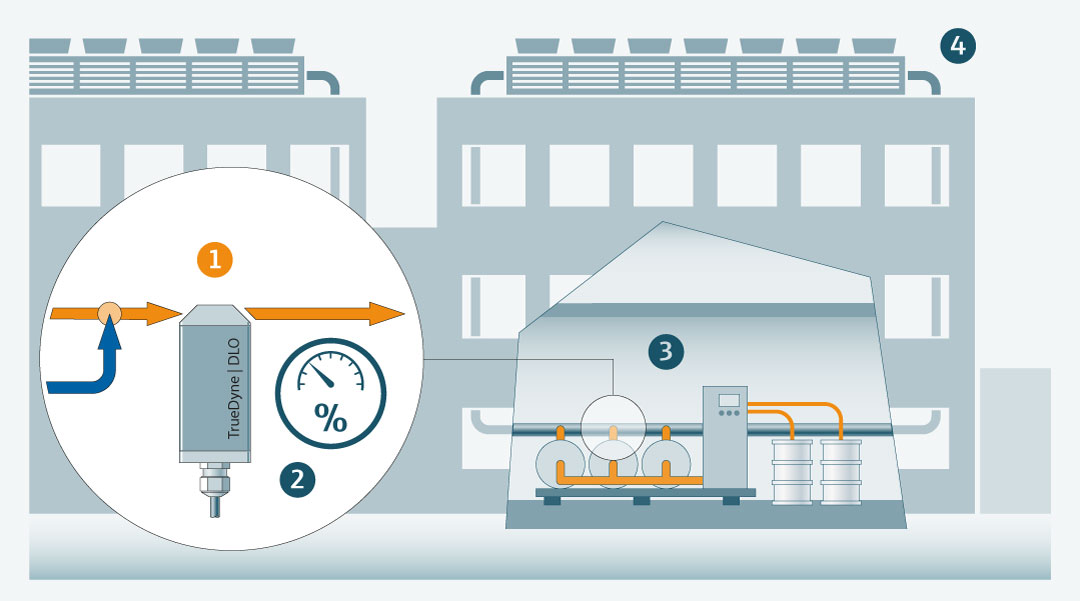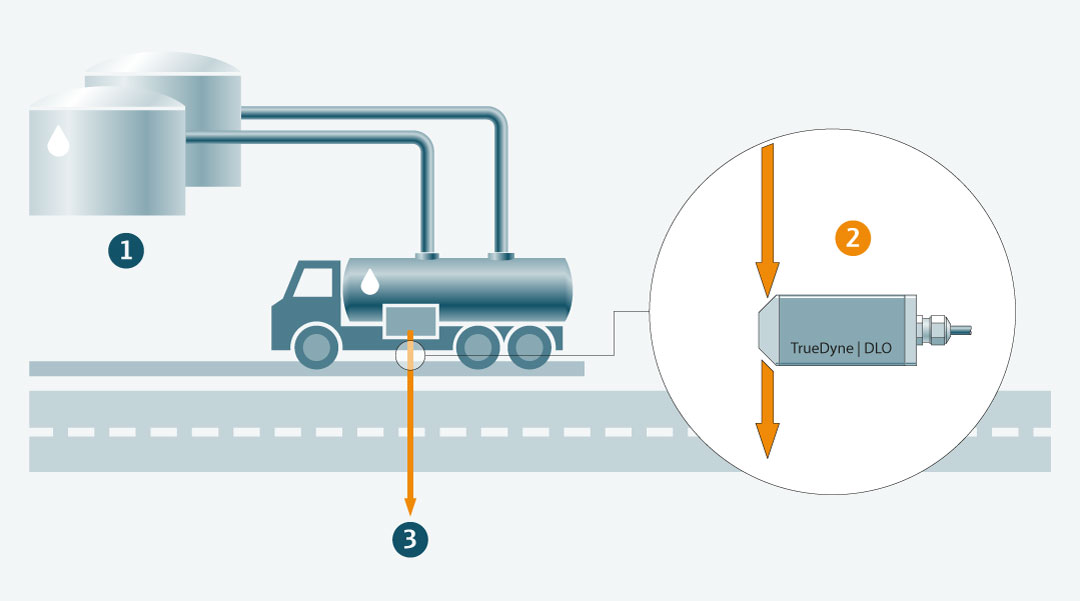DLO-M2 density sensor for liquids
The DLO-M2 sensor measures the density of liquids in a microelectromechanical system (MEMS system). Within the MEMS system, the liquid is directed to an omega-shaped microchannel, the so-called omega chip. This tiny silicon tube – it is hardly thicker than a hair – is set into oscillation for the measurement. The density of the medium can be derived from the natural frequency of this oscillation: the denser the medium, the lower the oscillation.
Thanks to the measurement in the MEMS system, the sensor is only 30 x 80 x 15 mm in size and can be accommodated even in tight spaces. The high-precision measurement results are immediately available, allowing continuous measurement during the process.
The density of liquids depends on their temperature. To compensate for this effect, an integrated platinum resistor detects the temperature of the liquid. The density sensor sends the measured data to the readout system via the data line in Modbus RTU transmission mode.
Technology
Overview
The density sensor was designed to measure the density of fluids. This is done with a microelectromechanical system (MEMS) with an omega-shaped microchannel (omega chip) built into an internal bypass. When a liquid flows through the density sensor, the bypass arrangement creates a pressure gradient across the microchannel, allowing the liquid to reach the omega chip. The liquid influences the physical properties of the excited sensor (resonance frequency and quality), these are digitalised and evaluated in the microcontroller. The measured values can be read out via the serial interface (RS-485, Modbus). Thus, density measurements in the range 600…1,000 kg/m3 (for further options see product specifications) can be realised at a flow rate of 0…10 l/h. settings.
Omega Chip
The Omega chip, a vibronic microsystem, is the heart of the measurement system and serves to generate the sensor signal in the overall system. The essential component of this microsystem is a silicon tube (microchannel) which is vibrated electrostatically in a vacuum. To compensate for temperature effects, a platinum resistor is integrated, which allows local real-time temperature detection. The Omega chip consists essentially of crystalline silicon and glass.

Measuring principle (omega chip)
Density Measurement
For density measurement, the density sensor uses the omega chip. The filled microchannel is set into resonant oscillation and analysed. The resulting natural frequency of the microchannel depends on the mass and thus on the density of the medium in the microchannel: the greater the medium density, the lower the natural frequency. The natural frequency is thus a function of the density of the medium.
![]()
f = natural frequency, E ⋅ I = tube stiffness, ρTube = tube density, ATube = tube cross-section, ρFluid = fluid density, AFluid = fluid cross-section.
- The DLO-M2_ex sensor measures liquid density in hazardous areas (ATEX: II1G, IECEx: Zone 0).
- Employs MEMS technology with an omega-shaped microchannel for precise density measurement.
- Despite its compact size (37 x 83 x 18.2 mm³), it fits comfortably into tight spaces.
- Integrated platinum resistor compensates for temperature fluctuations, ensuring accuracy.
- Data transmission occurs via Modbus RTU in RS-485 point-to-point connection mode.
- Ideal for real-time inline measurement with quick media changes.
- Offers high precision with a max measurement error of ±0.5 kg/m³ and repeatability of ±0.25 kg/m³.
- Suitable for various fluids, including hydrocarbons, aqueous media, and more.
- Optional concentration packages available for diverse liquids like sugar/water and ethanol/water.
- Applications include airfield refueling for precise mass calculation and concentration monitoring in refrigeration circuits.
From volume (l) to mass (kg)
For example, when a fuel is pumped from a truck into a tanker, the volume of the refuelled liquid is recorded as standard. However, since the densityvaries according to pressure and temperature, it is not possible to make precise statements about the mass. With the DLO-M2 sensor from TrueDyne, you can collect the necessary data on the density during the process and use them to calculate the mass (V-ρ=m).

1. Fuel is pumped from the truck to the tanker.
2. Standardised volumetric measurement in litres.
3. Installed in a bypass line, the density sensor DLO-M2 measures the density directly on the truck. Thanks to the compact design of the sensor, it can also be retrofitted into the process.
4. Together with the volumetric measurement, the density can be used to calculate the mass of the fuel in kilograms, which is then handed over to the customer.
Concentration monitoring
In most cases, the refrigerant in a cooling circuit consists of a mixture of ethylene glycol and water. The optimum concentration is determined depending on the minimum temperature entering the circuit to prevent the liquid from freezing. At the same time, the aim is to keep the water content as high as possible, as this has a positive effect on the thermal conductivity. So how can the concentration of the glycol-water mixture be monitored in the process? With TrueDyne’s DLO-M2 sensor, you collect the data you need to determine the concentration of the medium in the running process.

1. Density sensor with integrated glycol-water concentration calculation.
2. The concentration is output directly as a measured value.
3. Refrigeration plant and preparation of the concentration for cooling industrial applications.
4. Heat exchangers on the roof of factory buildings. Due to the circulation, water can evaporate and the concentration of the refrigerant changes. This is where the DLO-M2 is used for concentration monitoring.
Beer application
Alcohol is produced by fermenting a sugar source with a catalyst, typically yeast or certain bacteria. In the process, the carbohydrates (sugar and starch) are converted into carbon dioxide and ethyl alcohol. This serves as the basis for all alcoholic beverages, regardless of whether they are beer or spirits such as gin and whiskey. In order to be able to make a statement about the progress of the fermentation process, measurement samples must be taken and analysed regularly. This is exactly where TrueDyne’s DLO-M2 density sensor with integrated concentration determination comes in. Even with small sample volumes, a precise indication of the progress of the fermentation process is possible.

1. Taking a sample from a fermentation tank.
2. Preparation of the sample by degassing and filtering of turbid and suspended matter.
3. Density measurement with integrated concentration calculation of sugar in water. This enables a precise statement about the progress of the fermentation process.
4. Disposal of the test sample. Due to the sensor design and the resulting low sample volume, hardly any rejects are generated.
Quality monitoring
The density of a liquid depends on its composition. If different liquids are mixed, the correct mixing ratio can be checked with density measurements. For example, in the case of heating oil: according to the legal requirements, 7% biodiesel may be added to heating oil. Since this is tax-free, it is often used on the border of legality. With the DLO-M2 density sensor from TrueDyne, they monitor the quality of the heating oil in the running process.

1. Tanker truck for the delivery of heating oil.
2. The sensor measures the density of the heating oil directly at the transfer point. The data collected on site shows whether the right media are being refuelled in the correct ratio.
3. The product is handed over to the customer. Good quality is guaranteed.







